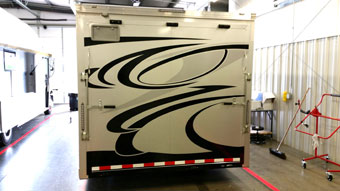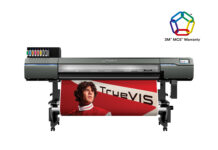Nothing beats the “wow” factor of an exquisitely wrapped vehicle. Thanks to the availability of high-quality materials and innovations in both printers and design software, designs in recent years have become even more eye-catching—making this form of advertising a marketing must-have for any serious business.
“Over the past decade, we’ve seen the industry shift from individual vehicle graphics to full custom wraps that utilize state-of-the-art print technology,” says Chris Cheney, vice president of sales at The Decal Source, Inc. (TDS), based in McLeansville, North Carolina.
The reasons behind this shift are multi-faceted, but they may be related to the ability companies now have to integrate improvements in vehicle graphics’ creation with sound installation practices and solid project management processes.
The latter point is one of the ways TDS works to ensure success with all of their projects.
In business since 1998, the company augments their customer service and project management by assigning a dedicated account service team to each customer.
“Each team consists of an account manager, A graphic artist, and an account coordinator who are paired together in a dedicated office,” says Cheney. “They are asked to learn the customer’s brand guidelines and intimate details of each project.”
This approach also allows the company to specialize in many areas, including banners, custom graphics, corporate designs, vehicle lettering and wraps, and other kinds of signs.
First Gear: Design
The Decal Source’s account service team also handles the design aspects.
“We manage our design process much in the same way we handle all other graphic orders—with a team-based solution,” says Cheney. “Our account service team will bring together a graphic designer and the client to discuss the client’s individual design needs while proposing options to help represent the client’s brand.”
The company uses the Adobe Creative Cloud and Adobe Illustrator as their primary design software.
“Illustrator is the ‘backbone’ of our operation; it gives us the capability to provide proofs quickly and easily in any type of file format that is preferred,” says Cheney.
Once TDS has received the approved design, it moves along to its setup team that prepares the files for print in full scale.
“Over the years, our team has utilized Illustrator to refine our setup process to maximize our yield and modify paneling techniques,” says Cheney. “Illustrator is highly compatible with our production workflow and easily integrates with our RIP and cutting software.
“This allows us to save time and hassle by easily making adjustments that are universally recognized by all of our software, at any point in the production process.”
Ultimately it’s the customer’s decision on how their vehicle graphic design turns out, but Cheney says simple is better.
“In a world where the time to make an impact on a consumer is so limited (sometimes only a few seconds), a clean design advertising the customer’s logo, contact info, and an attractive stripe help relay the message a lot faster and more efficiently,” he says. “We find that steering a customer away from an extremely busy design with several pictures and redundant wording helps produce a better overall design.”
Second Gear: Installation
A great installation is key to any project, so the TDS team takes additional time to create panels that are easy to install and minimize seam exposure.
In addition to being a 3M Certified Graphics Installation Company, TDS’s employees are members of the United Application Standards Group (UASG) and the Professional Decal Application Alliance (PDAA).
“Our install department is flexible and goes the extra mile to make it happen for our customers,” says Cheney, noting that this means working long hours or unusual schedules.
According to Cheney, proper education and hands-on training are two key elements of a successful installation department.

“We provide a training environment for new hires,” says Cheney. “This allows them to explore the limitations of certain materials and develop the special touch needed to cut the material properly.”
Third Gear: Projects
The Decals Source was able to put its expertise to work on a number of recent wrap projects.
On one of them, the shop was tasked with creating a design for a twenty-four-foot-long tag trailer that is pulled behind a metallic painted RV.
“Our client was very adamant that he wanted the stripes to mirror the painted RV,” says Cheney, “to tie it all in together.”
It took a little bit of innovative thinking to accomplish this.
The TDS print department ended up printing directly on 3M™ Wrap Film 1080-G120 Gloss White Aluminum metallic vinyl and color-matching each color on the RV while their design team recreated the RV striping to fit the trailer
“We’re always pushing the envelope with new films to help our customers,” says Cheney.
The Decal Source also worked on a large, custom box truck that showcases a top NASCAR driver and the sponsor’s product.
“Our client wanted to completely wrap the exterior of the box truck, including the roof as well as many interiors areas that tie in with the exterior design,” says Cheney.
This truck posed several challenges—from the customization of the vehicle surface to the complexity of the design to wrapping all of the surfaces (including interior ledges, trim, awning cover, etc.).
“We first created a custom template of the truck for the design that included all necessary bleeds to help alleviate issues in the production and installation of the wrap,” says Cheney. “As we completed the project, we learned how to calculate wrapping a dome in particular, as well as key areas to trim very carefully during install.”
In addition to the typical 3M wrap media used on vehicles, TDS utilizes 3M reflective vinyl applied on top of several wraps to showcase specific logos or verbiage at night.
“The additional reflective vinyl graphics make a normal wrap stand out above the crowd,” says Cheney.
Over the next few years, Cheney believes the industry will continue to see a broader array of wrapped film products with different textures and additional colors.
“Also we expect to see inks with increased longevity and vinyl media that will wrap more complex curved surfaces with increased conformability,” he says. “These types of products will ultimately expand the product gamut we can offer to customers and help create vehicle graphics that will stand out for many years to come.”
By Lori Shridhare
Photos: The Decal Source, Inc.











